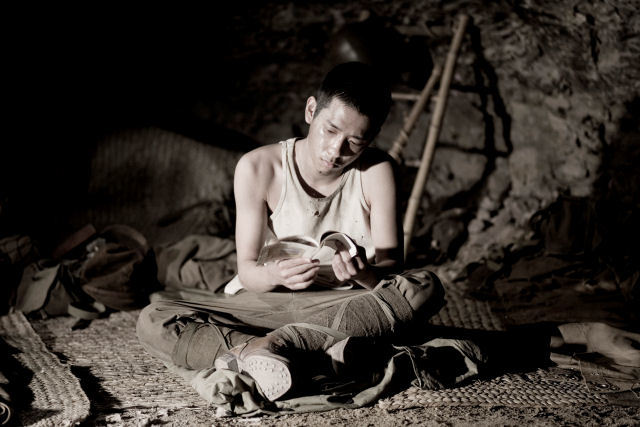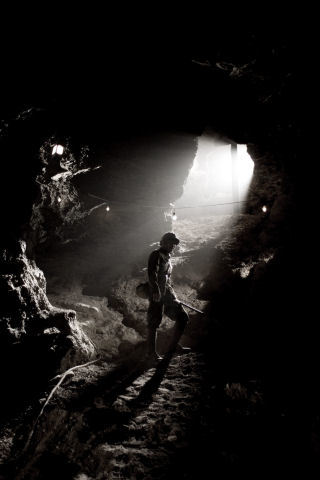
There's a throwaway line in Clint Eastwood's Flags of our Fathers that underlines the weakness in that film but promised that there was much more to come in his companion piece, Letters from Iwo Jima:
This was the fifth day, sir. The battle went on for thirty five more.
The story of the flag raised above Iwo Jima turns out to be a banal one and the film itself jumps around so much that it's hard to care for any of the characters whether they're being picked off on the black beach or getting drunk back in the States. Happily then, the companion piece is a much better movie. In fact we'll put our necks out here and say that Eastwood deserves Best Director Oscar and that Letters from Iwo Jima should walk away with the Best Film statuette.
We were worried that this would be a straight forward walk through of the earlier film's scenes from a slightly different perspective, but Eastwood seems a lot more committed to bringing the Japanese experience of Iwo Jima to life than the American one. The few flashbacks there are serve the characters well, but he wisely allows us to spend most of our time on the island, cranking up the fear and the despair as the doomed men dig in while waiting for the American fleet.
Iwo Jima is considered a part of Tokyo despite it being some 700 miles away and was a key strategic point during the closing section of World War II. Both the Japanese and the Americans knew it would be a key base for a later assault on the Japanese mainland. One side wanted it and the other side were determined not to give it up.
June 1944 and a new commander (Ken Watanabe, here giving a career-best performance) arrives expecting support from both the navy and airforce in defense of the island. First the few aircraft he has are recalled to Tokyo and then comes the news that the majority of the Japanese fleet has been destroyed. With his own officers distrustful of his plans, General Kuribayashi abandons the beachhead and traditional island defenses and instead orders his troops to dig into the very heart of the volcanic mountainside. What was supposed to be a quick mopping up exercise for the vast American force becomes a sustained month long siege. By its close almost 7,000 American men are dead with Japanese casualties topping 20,000.
12,000 of them are still there.

Eastwood deftly moves the camera from the general to the men under him. The heart of the film lies with Kazunari Ninomiya as Private Saigo, a baker conscripted into the army who wants nothing more than to return home to his wife and the daughter he has never met. His story connects with that of the general on three fateful occasions, as he not only has to survive the invading enemy, but also the fanaticism of the old guard commanders who see suicide as more honourable than defeat (two things we learned while watching this film: 1. we never ever want to be on the wrong end of a flamethrower, and 2. suicide by hand-grenade is very messy).
The other notable characters are Tsuyoshi Ihara's Lt. Colonel Takeichi Nishi, a famous Japanese Gold Medal winner at the 1932 Olympics in Los Angeles. Like Kuribayashi he has fond memories of America and its people, who to his men are as demonised as the Japanese were to the Americans. Another regular soldier, Shimizu, is an ex-military policeman now torn between his indoctrinated duty and the reality of war. One character with no such wavering in his belief system is Lieutenant Ito (played by Shidou Nakamura, last seen in Jet Li's Fearless) who has an unflinching sense of honour and seems to seek death out as the only viable option.
The Americans are hardly glimpsed for most of the film. The gigantic Armada is much more intimidating when seen from the Japanese positions and with a couple of exceptions the Americans become this unstoppable mass bringing death and ultimately disgrace for Japan. Honour of course is a big theme with General Kuribayashi railing against the idea that it is better to die with honour than to escape to regroup and fight back.
Overall though the focus is on the human cost of the war and this is where the titular letters work so well. Only discovered a few years ago by an archaeological team, letters that never reached home are now read over the film. Sometimes mundane, often funny, it's the words of the dead men that help raise the film a few notches over other recent war films and puts Letters from Iwo Jima way above sentimental claptrap like Saving Private Ryan.
The fact that Eastwood brings this story to the screen so well while hardly understanding any of the language spoken throughout the film is quite an achievement and it's really hard to see how he'll be able to top this one. Scorsese should ask for an assistant director position on his next film - he could learn a thing or two.
Letters From Iwo Jima is released on 23 February and has received four Oscar nominations for Best Motion Picture of the Year, Achievement in Directing (Clint Eastwood), Achievement in Sound Editing and Original Screenplay. You can watch the trailer here. The official website is here.
Above images: © Warner Bros Ent Inc 2007



